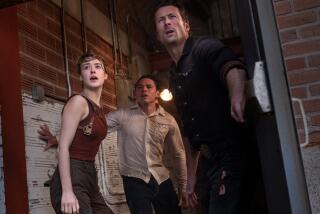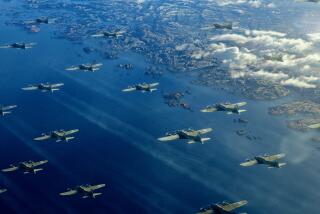Timeless with no strings attached
When the movie “Thunderbirds” opens in theaters across the country next Friday, it will not be the first time the franchise has hit the big screen, merely the first time that the actors do not have heads made from plasticene and strings attached to their arms.
In synergistic honor of the new release, two earlier Thunderbirds movies, “Thunderbirds Are Go” (1966) and “Thunderbird 6” (1968), enacted entirely by puppets (and the odd inserted human hand), have just come out on DVD in a slipcased box set that includes the usual array of extras and improvements (commentary tracks, featurettes, trailers, photos, “Easter eggs,” 5.1 soundtrack, widescreen format), plus a sheet of magnets and cardboard rocket ships to fold and build.
Not having seen the new film -- which cost a reported $70 million, stars Ben Kingsley, Bill Paxton and Anthony Edwards among a bushel of less well known young people, and features a closing titles theme by the British punk-pop group Busted -- I can nevertheless say with some assurance that, whether it is a bomb or the bomb, it will be something very like something you have seen before and soon will see again, a variation on a variation on a variation of a thing that made a lot of money. (Advance reports adduce “Spy Kids.”)
The original “Thunderbirds,” on the other hand, was like nothing else, or at least nothing that wasn’t also the work of its creators, Gerry and Sylvia Anderson. “Supermarionation” was the Andersons’ meaningless but cool-sounding term for several puppet shows they created for British television (and American syndication) some four decades back, a body of work so splendidly strange and, more important, so labor-intensive that, as far as I know, it spawned no imitators.
The “Thunderbirds” TV series (already out on DVD and being shown on the cable network G4techTV ) went on the air in 1965 after “Supercar,” “Fireball XL5” and “Stingray,” other sci-fi adventures built around amazing machines and, like “Thunderbirds,” set about 100 years in the future. Although even more sophisticated Supermarionation series were to follow (as well as the live-action “UFO” and “Space: 1999”), “Thunderbirds” is the quintessential Anderson creation.
Inspired in part by “Bonanza,” the series concerns millionaire former astronaut Jeff Tracy and his five sons -- Scott, Virgil, Gordon, John and Alan, all named for real-life American astronauts -- who, from their secret tropical island home, run International Rescue, a global (and sometimes extra-global) disaster response team. Helping them in their work are Brains, Tin-Tin and the glamorous Lady Penelope, who tools around in a six-wheeled pink, late-model Rolls Royce -- 2065 is pretty late-model -- driven by her cockney chauffeur, Parker.
Apart from the rocket ships and ubiquity of “atomic power,” the Andersons’ world of 2065 looks amazingly like that of 1965. (I watched “Thunderbirds” as a child and never realized it was set in the future.) The fashions are strictly Carnaby Street, the sets recall the golden age of James Bond, the very faces of the puppets are modeled on stars of the day. Apart from Lady Penelope and Tin-Tin, women don’t do anything important. (Even though it’s peopled entirely by dolls, “Thunderbirds” is a man’s world.) And “F.A.B.,” which is not an acronym but a spelling out of the popular ‘60s encomium, is Thunderbirdese for “A-OK.”
Also old-fashioned are the effects and editing. Unlike the attention-deficit pacing of current action movies -- the new “Thunderbirds” surely included -- the original episodes and films are often slow enough to let you go to the kitchen, make and eat a sandwich, drink a big glass a milk and get back without missing anything of substance, and I don’t mean that as a criticism. The first several minutes of “Thunderbirds Are Go” are taken up with the assembly of the Mars-bound rocket ship Zero X, accomplished with the ritual deliberation of a Greek Orthodox mass; models move ponderously across an airstrip beneath a painted sky as voices intone things like “Radio Controlled Lifting Body One about to take up launch position” and “Fuel temperature is correct; all pre-start lights are green.”
Also slow-moving are the Tracys themselves. That they keep cool in even the most perilous situations is partly because they have no alternative: Their bodies are ill-equipped for fighting, or running, or even opening their mouth wide enough to scream, and the more that they are required to do, the more they remind you that there are people somewhere above them pulling their well-disguised strings. To promote realism -- a strange conceit, all things considered -- the characters spend a lot of time nearly motionless, sitting, at desks, consoles, tables or control panels, or casually posed against railings or walls, and let the model rockets and cars and boats (all manipulated in real time) take care of the heavy work and hard action.
Though the theatrical films are not universally beloved by “Thunderbirds” aficionados, the wider screen and bigger budget have their undeniable rewards: more dynamic compositions, bigger sets, bigger rockets. Zero X, the mechanical star of “Thunderbirds Are Go,” has been designed to fill the wide screen. And there is an added layer of glamour -- Sylvia Robinson, who produced the films, was as concerned with this element as with the keen machines and signature explosions. “Thunderbird 6,” which takes place on the round-the-world trip of a kind of giant steel dirigible, and provides occasion for set pieces in an Indian bazaar and a theme restaurant in the Swiss Alps. The conclusion of that film, which builds from a shoot-out in the Gravity Compensation Chamber among spinning, um, gravity compensators, to a rescue by biplane, including live-action stunt flying, is as exciting as can be. “Thunderbirds Are Go” features a dream sequence starring a puppetized Cliff Richard and the Shadows -- big pop stars in England, little known here -- who perform the original composition “Shooting Star” in a kind of early music video.
That the live-action “Thunderbirds” will one day look as quaint as these original films do now is, of course, inevitable. (George Lucas has already found it necessary to digitally “improve” the original “Star Wars.”) And yet, nearly 40 years on, they continue to work -- the willing suspension of disbelief is a wonderful thing. That almost all of the Andersons’ work is available on DVD, in lavish boxed sets, is testament to their power -- they’re the kind of shows one wants to remember, or to share. However silly they are, and they are very silly, they draw you in and do with you what they will.
*
‘Thunderbirds’
What: “Thunderbirds Are Go” and “Thunderbird 6” DVD box set
From: MGM Home Entertainment
MPAA rating: Not rated
Price: $24.58
Both produced by Sylvia Anderson and directed by David Lane
More to Read
Only good movies
Get the Indie Focus newsletter, Mark Olsen's weekly guide to the world of cinema.
You may occasionally receive promotional content from the Los Angeles Times.










